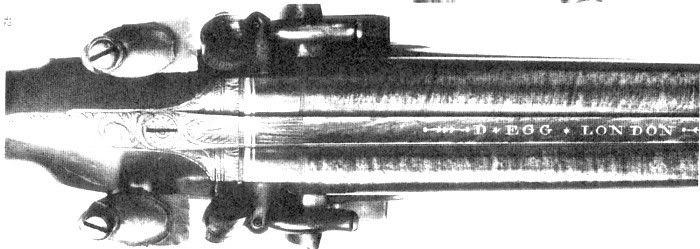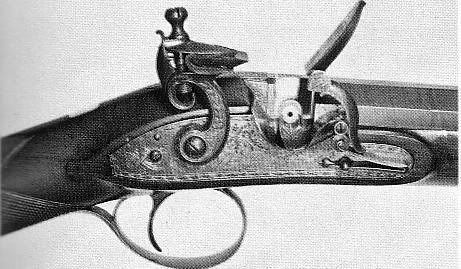As I was looking thru one of my books I couldn't help of thinking about this Smoothbore Site.
The book is the kind which often is on the big bookstores bargin counter, not because it is poor but because it is going out of print and/or it is forign so the stores picked them up for a song. This book cost me $2.98 back in the mid '80s.
The photos below came from "Sporting Guns" by Richard Akehurst
Copyright 1968, Published by Octopus Books Limited, London pp 42,45 and 46.
Although shooting birds on the wing was popular on the Continent for many years, it took some time for it to catch on in England.
When it did, the English Gunsmiths were quick to develop the shotgun into some of the best in the world.
The photos below show what the books author feels is the ultimate in Flintlock Doubles and in these photos you should note that in an effort to reduce the width and bulk of the guns, the locks are positioned in board from their usual position along side of the barrel.
This was accomplished with the use of the Patent Breech and machining the barrel sides down so the touch hole is just outside the breech chamber. It does make for a slim gun.
The first picture is of a Durs Egg Double made around 1820:

Notice the flats and position of the pan cover are a considerable distance in board from the outside of the barrels. The frizzens seem to be cocked outboard to clear the outside of the barrel.

This gun was made by John Manton in 1820. Note the machined flat which the platinum liner screws into. Also note that the frizzen swings up clear of the barrel sides.

This gun was made by James Purdey around 1820 and gives a nice view of the pan and fence. It also shows the same deep cut into the barrel. It looks to me like the sideplate at the frizzen spring is actually narrower than the forearm.
The book is the kind which often is on the big bookstores bargin counter, not because it is poor but because it is going out of print and/or it is forign so the stores picked them up for a song. This book cost me $2.98 back in the mid '80s.
The photos below came from "Sporting Guns" by Richard Akehurst
Copyright 1968, Published by Octopus Books Limited, London pp 42,45 and 46.
Although shooting birds on the wing was popular on the Continent for many years, it took some time for it to catch on in England.
When it did, the English Gunsmiths were quick to develop the shotgun into some of the best in the world.
The photos below show what the books author feels is the ultimate in Flintlock Doubles and in these photos you should note that in an effort to reduce the width and bulk of the guns, the locks are positioned in board from their usual position along side of the barrel.
This was accomplished with the use of the Patent Breech and machining the barrel sides down so the touch hole is just outside the breech chamber. It does make for a slim gun.
The first picture is of a Durs Egg Double made around 1820:

Notice the flats and position of the pan cover are a considerable distance in board from the outside of the barrels. The frizzens seem to be cocked outboard to clear the outside of the barrel.

This gun was made by John Manton in 1820. Note the machined flat which the platinum liner screws into. Also note that the frizzen swings up clear of the barrel sides.

This gun was made by James Purdey around 1820 and gives a nice view of the pan and fence. It also shows the same deep cut into the barrel. It looks to me like the sideplate at the frizzen spring is actually narrower than the forearm.







